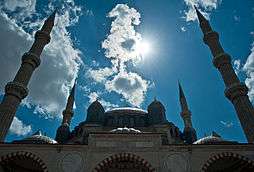Yusuf Hamadani
Hadrat Abu Yaqub Yusuf Hamdani (born 1062 /440 H - died March 1141 /Rajab 535 H) is the first of the group of Central Asian Sufi teachers known simply as Khwajagan (the Masters) of the Naqshbandi order. His shrine is at Merv (Turkmenistan).
Life
| |
|---|
 |
|
Lists |
|
|
Born in Buzanjird near Hamadan in 1062, he moved from Hamadan to Baghdad when he was eighteen years of age. He studied the Shafi'i school of fiqh under the supervision of the master of his time, Shaykh Ibrahim ibn Ali ibn Yusuf al-Fairuzabadi. He kept association in Baghdad with the great scholar, Abu Ishaq ash-Shirazi, who gave him greater deference than to any of his other students although he was the youngest.
According to Ibn Khallikan, he began his religious career with the cultivation of the religious sciences, becoming both a respected scholar of hadith and fiqh and a popular preacher in Baghdad. He was so brilliant a jurisprudent that he became the Marja of his time for all scholars in that field. He was known in Baghdad, the center of Islamic knowledge, in Isfahan, Bukhara, Samarqand, Khwarazm, and throughout Central Asia.
Later he abandoned these pursuits, adopting an intensely ascetic way of life and travelled east, first settling in Herat and later in Merv, where his tomb is still reputed to exist. He became an ascetic and engaged in constant worship and mujahada (spiritual struggle), instructed by Shaykh Abu 'Ali al-Farmadhi. He associated with Shaykh Abdullah Ghuwayni and Shaykh Hasan Simnani. He named four khalifas or successors, a pattern that repeated itself for several succeeding generations of the Khwajagan, including Ahmed Yesevi and Khwaja Abdul Khaliq Gajadwani, the next link in the Naqshbandi silsila.
Sources
The Naqshbandi Order, Hamid Algar Wafayat al-A'yan, Ibn Khallikan
Bibliography
- Abu Ya`qub Yusuf ibn Ayyab ibn Yusuf ibn al-Husayn al-Hamadani——May Allah Sanctify His Soul; http://web.archive.org/web/20120303111446/http://www.naqshbandi.org/chain/9.htm
- Omar Ali Shah (1998). The Rules or Secrets of the Naqshbandi Order. Tractus Books. ISBN 2-909347-09-5.
- John G. Bennett (1995). The Masters of Wisdom. Bennett Books. ISBN 1-881408-01-9.
